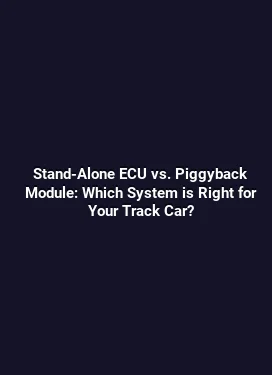How to Datalog and Analyze Engine Parameters for Safe Tuning
Foundations of Datalogging for Engine Tuning

Engine tuning starts with a solid foundation of data. Datalogging is the systematic recording of sensor data over time, creating a traceable record of how the powertrain behaves under different operating conditions. A well-structured data log helps identify AFR (air-to-fuel ratio) deviations, ignition timing variations, boost changes, and sensor health, enabling precise adjustments without compromising reliability. The practice combines robust hardware, calibrated sensors, and disciplined sampling strategies to deliver meaningful insights rather than noisy signals.
Key components of a datalogging setup include an interface to the ECU or data bus, a reliable storage medium, and software capable of filtering, aligning, and visualizing signals. In modern applications, data is captured from sensors such as wideband O2, MAP and MAF, throttle position, RPM, knock sensor, EGT, and boost pressure. The goal is to create a cohesive picture of how the engine delivers power under load, acceleration, cruising, and transient events like quick throttle inputs or gear changes.
Choosing the Right Data Channels

Not every signal is equally informative for every tuning objective. For safe, performance-oriented work, prioritize channels that directly influence risk and reward. Fuel-related signals (AFR, injector duty cycle, fuel trims) reveal mixture stability. Timings (ignition advance, cam phase, boost target, wastegate position) show how far the engine operates from safe margins. Sensor health indicators (voltage references, sensor frequencies, latency) help detect failing hardware before it distorts results. Structuring data around these core channels makes downstream analysis clearer and more actionable.
In practice, establish a baseline log for a controlled drive—constant RPM, smooth throttle, and steady loads. Then record a load sweep, from light to heavy, to observe how the engine responds across the operating range. This approach surfaces non-linearities, such as fueling lag, sensor lag, or timing pull under high load, which are critical for safe tuning decisions.
Data Acquisition and Sensor Calibration for Accurate Logs
Accuracy at the source is essential. Datalogging begins with sensor calibration and validating the signal chain. A wideband AFR sensor, for example, must be calibrated to account for lag and sensor drift at different temperatures. Incorrect AFR readings can lead to over-rich or lean conditions that cause reliability issues or performance losses. Calibration should be performed across the full operating envelope, including cold start, warm-up, and high-load transients.
Supplementary sensors also require attention. Temperature sensors, manifold pressure sensors, and knock sensors can influence how the ECU interprets data. If a MAP sensor reads low due to a wiring issue, the fuel maps may respond inappropriately, causing knock or misfires. Verifying wiring integrity, connector cleanliness, and impedance compatibility minimizes erroneous signals, ensuring the log reflects real engine behavior rather than electrical noise.
Best Practices for Sampling and Synchronization
Sampling rate matters. High-frequency events such as injector pulses and knock spikes occur on the millisecond scale, while RPM changes can be captured at lower rates. A practical strategy is to sample critical channels at high frequency (e.g., 1000 Hz for knock and MAP) and secondary channels at a lower rate (e.g., 100 Hz for ambient temperature). Time-synchronization is the glue that binds the data streams. Align all channels to a common time base to prevent phase misalignment from distorting interpretations of cause and effect during transients.
Data integrity also depends on reliable storage and post-processing. Store logs in lossless formats, maintain a clear timestamp, and use consistent units across sessions. Pre-processing steps such as outlier rejection, smoothing of noisy channels, and normalization help prevent spurious conclusions while preserving genuine engine dynamics for analysis.
Analyzing Logs for Safe Tuning: From Signals to Decisions
Transforming raw data into actionable adjustments requires a disciplined analysis workflow. Start with a high-level overview of operating envelopes, then drill into specific events that challenge safety margins. The core objective is to verify that key parameters stay within safe limits under all anticipated operating conditions, while extracting performance improvements without crossing thresholds that could compromise longevity.
Air-fuel ratio and fuel trims are primary safety indicators. A healthy system maintains a stable stoichiometric or slightly stoichiometric range under load, with trims within a tight tolerance band. Deviations indicate either fueling issues, sensor faults, or timing-related interactions that can lead to knock or misfires if left unaddressed. Anomalies during acceleration or sudden throttle responses warrant closer inspection of injector timing, fuel pressure, or boost control behavior.
Ignition timing is another critical safety parameter. Advancing timing generally increases power but also raises the risk of knock if the fuel is not sufficiently resistant to detonation. By analyzing knock sensor activity in tandem with timing, it is possible to identify safe margins where power is gained without incurring damaging detonation. Logging heat-related signals, such as EGT, complements timing analysis because excessive exhaust temperatures correlate with lean conditions or over-advanced timing under load.
Interpreting Transients: Acceleration, Tuning Windows, and Safe Margins
Transient events are where the engine experiences the greatest stress. A rapid throttle input can cause a temporary lean spike if the fueling system cannot keep up. Datalogging helps differentiate a benign transient from a persistent lean condition that could harm the engine. In practice, examine fuel trims and injector duty cycles during fast pedal movements, ensuring the system responds within a predictable window and returns to steady-state values quickly after the transient ends.
Boost management presents its own challenges. In turbocharged or supercharged engines, the relationship between boost target, wastegate response, and intercooler efficiency determines the maximum safe power. Logs should reveal whether boost ramps are smooth, if wastegate duty cycles stay within safe bounds, and if compressor surge or instability appears at the edges of the operating range. When safe margins are approached, the data should guide conservative adjustments rather than aggressive ones.
Practical Steps for Safe Tuning Based on Datalogs
Derived insights should translate into repeatable tuning actions. Start with a structured plan that prioritizes reliability, then incrementally implement changes while continuing to log the results. This approach reduces the risk of unintended consequences that could compromise engine life or drivability.
Step 1: Establish baseline health and performance. Capture representative logs during cruising, acceleration, and sustained high-load conditions. This baseline defines a reference for future comparisons and helps detect drift in sensor performance over time.
Step 2: Normalize sensor signals. Apply calibration corrections and unit consistency across all channels. Normalize magnitudes so that comparisons across sessions are meaningful. Normalization eliminates scale discrepancies, making trend identification straightforward.
Step 3: Identify safety boundaries. Determine acceptable ranges for AFR, fuel trims, ignition timing, and boost under different operating conditions. Document these boundaries as guardrails for subsequent tuning iterations. Guardrails act as early-warning indicators that prevent pushing beyond safe limits.
Step 4: Incremental adjustments with verification. Make small, well-documented changes to fueling or timing. Immediately re-log to verify the impact and ensure no new risk factors emerge. If a change improves power but elevates a safety parameter beyond the guardrail, revert and try an alternative strategy, such as refining fuel pressure or adjusting load-based timing curves.
Step 5: Validate across real-world scenarios. Test the tuned configuration under varied conditions: hot and cold starts, long climbs, city drives, and highway cruising. Logs from these scenarios confirm whether the tuning remains safe across the intended use cases and helps expose edge cases that may not appear in controlled sessions.
Trend Analysis and Semantic Context for Longevity
Beyond individual events, trend analysis highlights long-term changes that could affect safety and performance. Visualizations such as time-series charts, scatter plots of AFR vs. RPM, and heatmaps of ignition timing across load ranges provide intuitive insight into how the engine behaves under sustained operation. Recognizing gradual drift in sensor readings, sensor aging, or slight calibration shifts helps maintain a robust tuning strategy over time.
Semantic interpretation of data emphasizes relationships between signals. For example, a consistent pattern where small ignition timing adjustments correlate with immediate fuel trim corrections suggests a tight coupling between combustion stability and fueling strategy. Understanding these relationships enables targeted adjustments that improve efficiency and durability without imposing excessive risk on the engine’s mechanical components.
Additionally, safety margins should be treated as dynamic guards rather than fixed walls. Regular re-evaluation of limits, informed by logs and real-world feedback, ensures that tuning remains aligned with evolving fuel quality, environmental conditions, and vehicle usage patterns. This adaptive approach supports long-term reliability while still delivering meaningful performance gains.
Organizing Data for Effective Review
Structured reports that pair visual dashboards with concise narratives enhance decision-making. A well-organized review includes sections for sensor health, baseline comparisons, transient performance, and final guardrail status. Clear annotations on plots help engineers quickly pinpoint the root cause of an observed issue, such as a spike in knock sensor readings following a sudden boost change or a lag in AFR response after a partial throttle input.
In practice, maintain a log book of tuning decisions alongside corresponding data. This historical context enables rapid rollback if a new configuration introduces unforeseen behavior. The goal is a repeatable process that delivers predictable outcomes while preserving engine safety and longevity.
Real-World Scenarios: Case Studies of Safe Tuning
Case study examples illustrate how datalogging informs safe tuning strategies. In one scenario, a high-performance turbocharged setup exhibited lean spikes during rapid throttle raises. By examining AFR and injector duty cycles, the engineer identified timing-related compensation that caused a temporary lean condition. The solution combined a conservative adjustment to fueling response with a modest delay in timing advance during fast transients, validated by subsequent log reviews that showed rapid stabilization and no knock activity.
In another case, a naturally aspirated engine displayed elevated exhaust temperatures at sustained high loads. Through log analysis of EGT and MAP, the team traced the issue to marginal fuel pressure under load. Restoring fuel pressure margins, along with a small enrichment during peak torque ranges, produced a balanced improvement in power and thermal stability, as confirmed by follow-up logs.
Safety-First Mindset in Tuning Practices
Adopting a safety-first mindset means prioritizing reliability alongside performance. Datalogging provides a quantified framework for evaluating risk and reward, ensuring that tuning actions do not push the engine beyond its proven endurance. Practitioners who combine meticulous data collection with disciplined validation cycles are better equipped to deliver sustained gains without compromising engine health.
Ultimately, the practice of datalogging and analysis is a blend of precise measurement, informed interpretation, and careful decision-making. By continuously refining data collection methods, calibrations, and review procedures, engine tuners can achieve safer, more reliable performance enhancements that stand the test of time.






